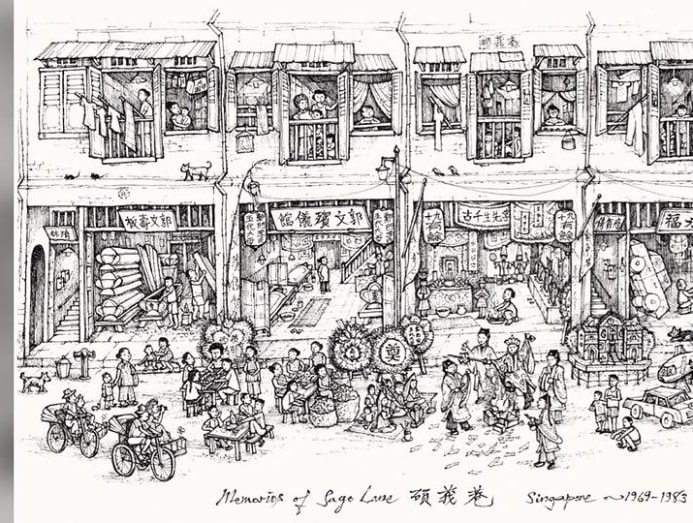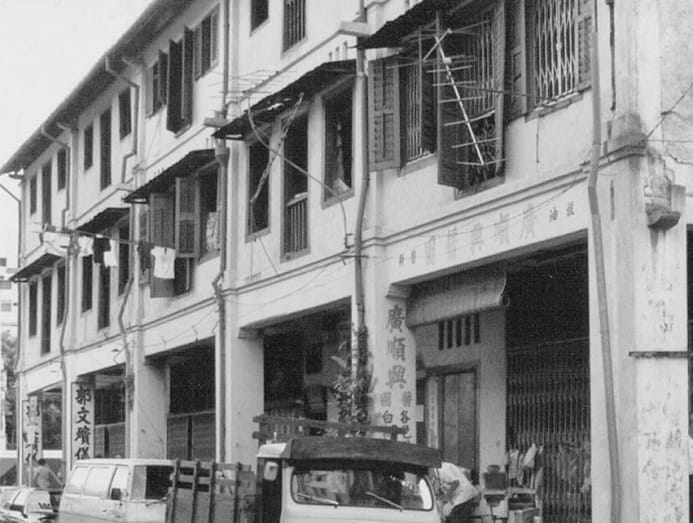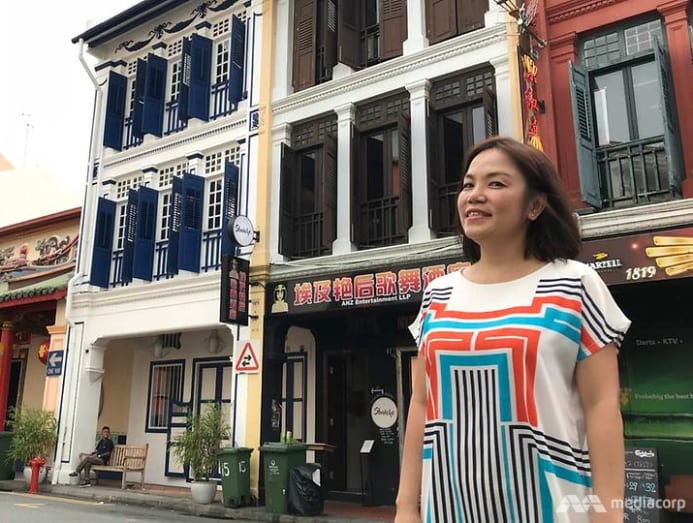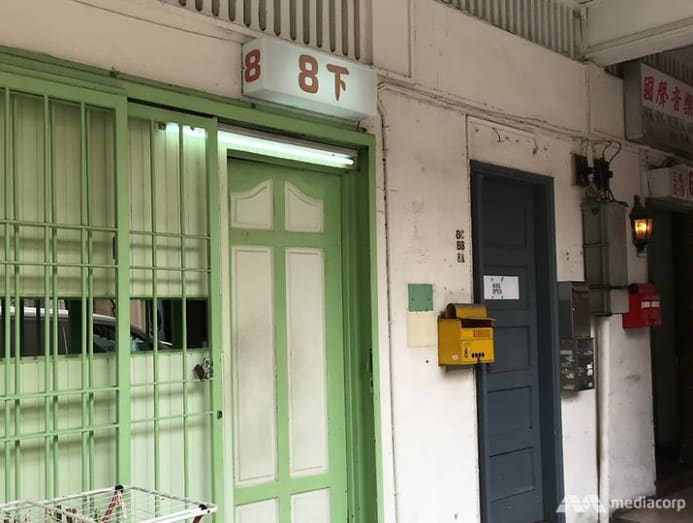My childhood Chinatown: How I lived with prostitutes, gangs, corpses
These days, Chinatown has become synonymous with two things: Hordes of tourists who soak in the sights at Temple and Pagoda Streets, or bar-hoppers on their mode to that hip, new F&B outlet.
But for three Singaporeans who grew upward at that place decades ago, Chinatown was way more a tourist trap or a nightlife destination. Information technology was a dingy, dodgy and sometimes even dangerous place to live in. But theirs was a childhood to remember. Here are their stories.
YIP YEW CHONG: 'THE CORPSE WAS SITTING Upward!'
Information technology'due south ane of the well-nigh macabre childhoods one could ever take: From the moment he was built-in until he was teenager, Yip Yew Chong spent his time around dead people.

The 49-twelvemonth-quondam accountant-artist, who'south known for his Instagram-friendly nostalgic murals in places such as Tiong Bahru and Kampong Glam, lived with his family at the infamous Sago Lane, likewise known as the Street of the Dead.
Today, it is nil more a busy carpark right beside the Buddha Tooth Relic Temple, and simply across the road from Maxwell Food Eye and a short walking altitude from the busy nightlife area of Erskine Route and Ann Siang Colina. But during the 1970s and 1980s, his family unit lived on the second floor of a shophouse smack in the middle of action.
"In the day, there were funerals, and at nighttime, there would be wakes. When I went downstairs, I'd have to walk past funeral parlours and the corpses would be on wooden planks. Subsequently a few days, they'd wash the corpses out in the open before putting them inside coffins. Zilch in those days was germ-free simply you get used to it!" recalled Yip, with a express mirth.

His family was literally surrounded by things related to death. The store beneath them sold paper effigies and nearby were a couple of funeral parlours. Opposite the street (where the temple now stands) were shops that made mourning clothes and coffins.
From his second-floor vantage point, Yip had a bird's eye view of everything. "It became very interesting at night. There would exist rows of tables out on the streets during the wakes and at 10pm, the rituals would starting time. A priest would spit kerosene into a pocket-sized bonfire, which would result in a fireball direct underneath our house – every other night," Yip said, adding that he had to put up with the racket, besides.

"I recollect studying for PSLE and it would be tung-tung-chang-tung-tung-chang all day and night!"
During the day, the street was just equally lively as huge, colourful paper effigies would be displayed along the street, and trishaws begetting tourists would often stop by to take pictures.
Every bit a immature boy, Yip as well heard of some unusual stories.
"One time, in that location was an ambulance that came (to deliver a corpse) and when the door was opened, in that location was a commotion because the corpse was sitting upwards!" he laughed. "Peradventure the muscles had contracted or something only people were talking about it for weeks."
Another incident involved the police dropping past during the last few days of a wake. The corpse had already been in the coffin for a week and the constabulary, who was investigating an incident, demanded it be opened.
"By the time you put a body within a coffin, it already smells – and when they opened information technology, wah, the whole street stank!"

In 1983, a 14-year-old Yip and his family unit had to movement as the shophouses was slated for demolition as part of the authorities's plan to clean up the Singapore River – and Chinatown was identified every bit one of the master sources of all the rubbish.
Together with the other residents and hawkers along Sago Lane, they moved to nearby Chinatown Complex.
"But the strange thing was, subsequently the street was demolished, the place was a grass patch for many years and we could see it from our new home," said Yip, adding that the empty land would get the site of operas and temporary marketplace stalls.
Ironically, when his begetter died in 2009, the family unit set up the wake on that very same patch where Sago Lane once stood.

Despite having created murals of old Singapore all around the city (including a recent ane at Chinatown Circuitous), Yip hasn't done anything related to Sago Lane due to the taboo surrounding death.
But he hasn't forgotten it. I of his very kickoff murals included an image of an amah (a domestic helper/nanny), the same woman who had lived with his family unit as a fellow boarder on 9A Sago Lane.
VICTOR YUE: 'MY UNCLE WAS ONCE Browbeaten UP'
If you thought your childhood was tough, effort telling that to Victor Yue, who grew upwardly in Chinatown with no proper toilets, and always having to keep an eye out for gangsters.

"A lot of the streets were gangster-infested. Dissimilar gangs had unlike turfs and when you lot're around 10 years former, y'all take to be careful not to step into another's turf, you know?" said the 65-year-old retired engineer and heritage enthusiast.
His elders would likewise warn him to be alarm when passing by coffeeshops. "In those days, they'd say you better be careful – when cups go overturned, you lot run for your life. It's a sign of a fight!"
Yue has lived in different parts of Chinatown all his life and spent his showtime 10 years at 29 Craig Road. Today, the row of shophouses where he lived has fabricated way for Craig Place condominium, where foodies drib by today for the Spanish tapas twin restaurants Binomio and El Tardeo.

Simply Yue's bright memories of the surface area as a kid during the 1950s and 1960s was dissimilar. His family unit rented a room on the upper floor of a Peranakan woman'southward shophouse – which proved tricky because the row of houses on the street had no sewage system and relied on nightsoil carriers.
"It stank and sometimes, if you get and s**t at the incorrect time, you tin can detect that the bucket has disappeared considering the guy came to alter it," said Yue. "And since we were on the 2nd floor, yous e'er prayed that when the guy walked upwards the flight of stairs, he didn't spill!"
Nevertheless, Craig Road had enough to entertain inquisitive youngsters like Yue, who would wander around the area up to Duxton Route, which today is packed with confined and restaurants. Back then, at that place was a small-scale temple on the second floor of one of the shophouses, which was popular among residents. (Further up on Duxton Hill, where you've at present got 50'Entrecote The Steak & Fries Chophouse and Lucha Loco, was no man'due south land for kids like Yue, who wouldn't dare enter another gang's turf.)

Yue's immediate vicinity was every bit interesting. He recalled that at the corner of Craig Route and Neil Road was a Tiger Balm factory, while opposite information technology was an former building where Chinatown Plaza at present stands. "There were jambu and mango trees exterior and we kids used to look for the fruits to drop," he said.
There were as well a couple of interesting shops along the road, selling wooden swords for wushu practitioners and a rental stall for old Chinese comics. At i corner, the results of chap ji ki – an erstwhile illegal lottery – would also exist written out and sometimes his grandmother would ask him to check out the results.

Incidentally, there were also ii spirit mediums forth the street – including an one-time lady who lived in a shophouse simply beside where Pasta Brava at present stands. "She'd be cooking and someone would come for consultation. She'd stop cooking, go into a trance, give you lot communication, and so go back to cooking. She was a spirit medium on-demand," he quipped.
The street'southward colourful graphic symbol was also literally institute on the pavement and walls – Craig Road was in the late Lee Kuan Yew'south Tanjong Pagar constituency. Just Yue remembers there used to be an role of the opposition group Barisan Sosialis somewhere.
For a child, these were all developed stuff – just one affair he had to really be alert about were gangsters. Yue would remember sneaking to the nearby Yan Kit Swimming Circuitous for a dip – but he knew he was taking risks.

"A immature boy might come upwards to challenge you past asking: 'What number do you play?' which referred to gang numbers," he said. "If y'all quoted the wrong one, you'd be in trouble. If you thought yous could bully him, you'd meliorate picket out because behind him, there might exist a bigger guy watching."
Luckily, Yue never had whatever personal encounters by making sure he didn't devious far from dwelling house (gangs never harmed those who lived in in their turf, he pointed out). Only there was one incident when he was very young that proved besides shut for condolement.
"My uncle was one time browbeaten up through mistaken identity. We had to seek help from the elders to notice out, and later the gang apologised. In those days, the gangsters or secret societies had a lawmaking of deport, so apologies were very ritualistic. They had to give you candles and things to pray to your ancestors and gods as a form of a very formal apology."
CHARMAINE LEUNG: 'SOME MIGHT SHOW A LITTLE BIT OF Flesh'
Her mother ran a brothel. Her nanny was an alcoholic. And she once lived in fear of her friends discovering her dwelling was in a red low-cal district. Charmaine Leung's babyhood story is a Channel 8 drama waiting to happen.

At the moment, though, you can already read all about it in her memoir titled 17A Keong Saik Road. The 45-year-old author's moving story about growing upwardly in the surface area during the 1970s was published last year. The championship's address refers to her female parent's brothel, while Leung herself lived on the second flooring of the shophouse next door 15A with her nanny.
Today, 17A is a hip bar and eating house called Sluviche, while 15A is the role of German radio and television outfit ARD.
But some places have remained the same. Next door is the Cundhi Gong Temple, where Leung and her mother would often sit downwardly to watch their unusual globe get by. Merely opposite the route is a brothel that yet operates today, marked by a light box with the number 8.

"We'd sit around 6pm or 7pm and our view would exist the ladies from that place who would come out and burn incense for expert business," she recalled.
As a young child, she would often run into them every bit they walked to and from the brothels. "They'd wear nice dresses in pretty hot weather condition," said Leung. "And they weren't what ordinary people would clothing."
"Some might testify a lilliputian flake of mankind. But the dresses seemed more like what people would wear when going onstage to perform, or what a nice wearing apparel would be in the 1970s and 1980s but exaggerated. Their skirts would accept a bit of the can-tin can feel but shorter."

Back then, her mother'southward brothel was just one of the many along Keong Saik Road and nearby streets. "At whatever in one case, you can get upwards to xl to 50 of these. Every few houses, you'd run into the white box with the cerise words and numbers. "19" was one of the bigger ones with quite a lot of pretty, younger ladies," she said, adding that prostitutes would kickoff coming in at around mid-afternoon and the whole area would be the busiest betwixt 8pm and 10pm.
Of course, at that age, she was more or less oblivious to everything. "Overall, it never felt likewise dodgy because there were no transactions on the streets. But my perspective is really that of a child," she said.
But life in Keong Saik Road wasn't merely all about the brothels. Leung remembers loving the feeling of the street in the mornings.
"There was almost no life compared to at night when information technology was a lot buzzier. At that place was a sense of tranquillity. Outsiders didn't really dare to come in, so it almost felt like a urban center waking up," she said.

Leung besides remembers playing along the back alleys and visiting her neighbours at nearby Jiak Chuan and Teck Lim Roads. Most of them are gone at present, replaced by hip F&B places, but Leung remembers them vividly: Lime Firm and Harry's Bar used to house a refrigerator repair store and a paper box shop, respectively. The back half of Spanish bar Esquina, she pointed out, was where her favourite ice cream uncle used to be.
"It was just home-fabricated ice cream with flavours like cherry-red edible bean, durian, corn and attap chee, which was my favourite," she said.
Gentrification has undoubtedly changed the confront of Keong Saik Route, and Leung has mixed thoughts about information technology. While she welcomes the preservation of architecture and how some businesses embrace the place's history (Keong Saik Baker has done buns inspired by the shophouse's previous majie owner), she bemoans the absence of actual residents who tin can form a community.
"It has become a identify where people visit, eat and walk abroad. And sometimes, I experience everything's a bit besides brilliant – the place used to wait more lived in," she said.

Since coming back from Hong Kong, where she had been based, Leung has been active in promoting the area'south heritage. Aside from the occasional tours, she was likewise involved in the Chinatown segment of the recent Singapore Heritage Festival. She's also been helping to promote theatre group Drama Box's upcoming bear witness in June titled Chinatown Crossings, which looks at the hidden histories of the area.
In a way, all these is a continuation of her book, which was an effort non just to tell her story only that of an overlooked community.
"It was besides most people who, no matter what happened or how hard lives were, made the all-time of what they had. These are the stories of the early immigrants, of people who laid down the foundations for Singapore. Without these people, we probably wouldn't have what we have today."
Source: https://cnalifestyle.channelnewsasia.com/entertainment/chinatown-heritage-history-sago-lane-keong-saik-road-216006
Postar um comentário for "My childhood Chinatown: How I lived with prostitutes, gangs, corpses"